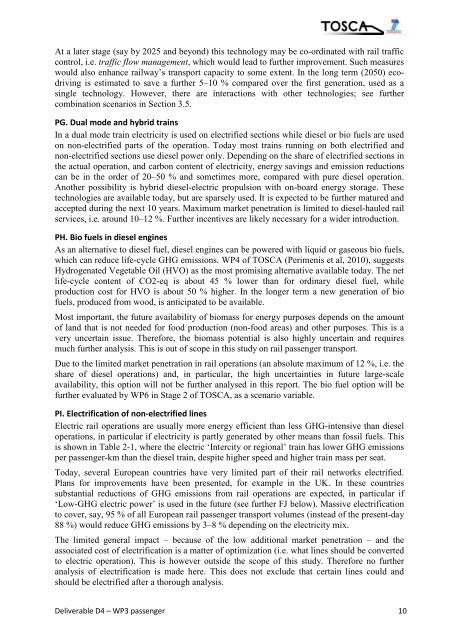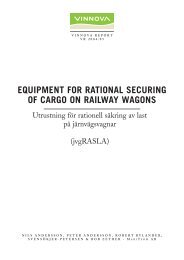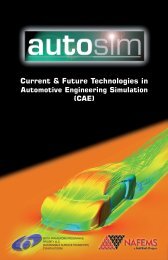WP3: Rail Passenger Transport - TOSCA Project
WP3: Rail Passenger Transport - TOSCA Project
WP3: Rail Passenger Transport - TOSCA Project
You also want an ePaper? Increase the reach of your titles
YUMPU automatically turns print PDFs into web optimized ePapers that Google loves.
At a later stage (say by 2025 and beyond) this technology may be co-ordinated with rail traffic<br />
control, i.e. traffic flow management, which would lead to further improvement. Such measures<br />
would also enhance railway’s transport capacity to some extent. In the long term (2050) ecodriving<br />
is estimated to save a further 5–10 % compared over the first generation, used as a<br />
single technology. However, there are interactions with other technologies; see further<br />
combination scenarios in Section 3.5.<br />
PG. Dual mode and hybrid trains<br />
In a dual mode train electricity is used on electrified sections while diesel or bio fuels are used<br />
on non-electrified parts of the operation. Today most trains running on both electrified and<br />
non-electrified sections use diesel power only. Depending on the share of electrified sections in<br />
the actual operation, and carbon content of electricity, energy savings and emission reductions<br />
can be in the order of 20–50 % and sometimes more, compared with pure diesel operation.<br />
Another possibility is hybrid diesel-electric propulsion with on-board energy storage. These<br />
technologies are available today, but are sparsely used. It is expected to be further matured and<br />
accepted during the next 10 years. Maximum market penetration is limited to diesel-hauled rail<br />
services, i.e. around 10–12 %. Further incentives are likely necessary for a wider introduction.<br />
PH. Bio fuels in diesel engines<br />
As an alternative to diesel fuel, diesel engines can be powered with liquid or gaseous bio fuels,<br />
which can reduce life-cycle GHG emissions. WP4 of <strong>TOSCA</strong> (Perimenis et al, 2010), suggests<br />
Hydrogenated Vegetable Oil (HVO) as the most promising alternative available today. The net<br />
life-cycle content of CO2-eq is about 45 % lower than for ordinary diesel fuel, while<br />
production cost for HVO is about 50 % higher. In the longer term a new generation of bio<br />
fuels, produced from wood, is anticipated to be available.<br />
Most important, the future availability of biomass for energy purposes depends on the amount<br />
of land that is not needed for food production (non-food areas) and other purposes. This is a<br />
very uncertain issue. Therefore, the biomass potential is also highly uncertain and requires<br />
much further analysis. This is out of scope in this study on rail passenger transport.<br />
Due to the limited market penetration in rail operations (an absolute maximum of 12 %, i.e. the<br />
share of diesel operations) and, in particular, the high uncertainties in future large-scale<br />
availability, this option will not be further analysed in this report. The bio fuel option will be<br />
further evaluated by WP6 in Stage 2 of <strong>TOSCA</strong>, as a scenario variable.<br />
PI. Electrification of non-electrified lines<br />
Electric rail operations are usually more energy efficient than less GHG-intensive than diesel<br />
operations, in particular if electricity is partly generated by other means than fossil fuels. This<br />
is shown in Table 2-1, where the electric ‘Intercity or regional’ train has lower GHG emissions<br />
per passenger-km than the diesel train, despite higher speed and higher train mass per seat.<br />
Today, several European countries have very limited part of their rail networks electrified.<br />
Plans for improvements have been presented, for example in the UK. In these countries<br />
substantial reductions of GHG emissions from rail operations are expected, in particular if<br />
‘Low-GHG electric power’ is used in the future (see further FJ below). Massive electrification<br />
to cover, say, 95 % of all European rail passenger transport volumes (instead of the present-day<br />
88 %) would reduce GHG emissions by 3–8 % depending on the electricity mix.<br />
The limited general impact – because of the low additional market penetration – and the<br />
associated cost of electrification is a matter of optimization (i.e. what lines should be converted<br />
to electric operation). This is however outside the scope of this study. Therefore no further<br />
analysis of electrification is made here. This does not exclude that certain lines could and<br />
should be electrified after a thorough analysis.<br />
Deliverable D4 – <strong>WP3</strong> passenger 10
















